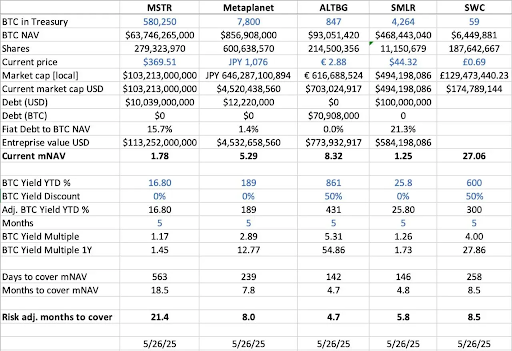Why we invest in SBET: The starting point for a new era of CeDeFi convergence
By Yetta (@yettasing), Venture Partner, Primitive Ventures
Sean Tan, Liquidity Partner, Primitive Ventures, and former Tower Research Macro Portfolio PM
preface
This article was written in May 2025. In May, we completed our PIPE investment in SharpLink, which is the first step of our focus on the PIPE market since the beginning of the year. Since the beginning of this year, Primitive Ventures has been actively deploying to capture the trend of CeDeFi convergence from a forward-looking perspective, and has taken the lead in focusing on Digital Asset Treasury PIPE transactions related to digital asset reserves. Within this framework, we systematically studied all representative transaction cases, and SharpLink is undoubtedly the most critical and representative one we have been involved in to date.
full text
We are pleased to announce that Primitive Ventures has participated in SharpLink Gaming, Inc.'s (NASDAQ: SBET) $425 million PIPE (Public Company Directed Private Placement) transaction. This investment provides us with unique exposure to invest in native businesses that have a strategy of stockpiling Ethereum. This investment structure combines options with long-term capital appreciation potential, reflecting our strong belief in Ethereum's strategic position in the U.S. capital market, and is in line with our overall judgment on the trend of institutionalization of crypto assets.
Why we invest
ETH vs BTC: The Spectrum of Productive Value
Compared with BTC, which lacks native earning ability, Ethereum, as an interest-bearing asset, naturally has the characteristics of producing staking income. BTC-based strategies, such as MicroStrategy, mainly rely on margin to purchase coins, and do not have self-generated income from assets, so the leverage risk is higher. SBET, on the other hand, has the potential to directly leverage ETH's staking yield and DeFi ecosystem to achieve compound interest growth on-chain and create real value for shareholders.
Currently, no ETH-collateralized ETF has been approved under the existing regulatory framework, and the public market is largely unable to capture the economic potential of Ethereum's yield layer. We believe SBET offers a differentiated path: with the support of Consensys, the company has the opportunity to implement protocol-native strategies that can lead to significant on-chain returns, and its model is expected to outperform even future ETH-staking ETFs.
In addition, Ethereum's implied volatility (69) is much higher than Bitcoin's (43), introducing asymmetric upside options to equity-pegged structures. This is particularly attractive to investors who execute convertible bond arbitrage and structured derivatives strategies, where volatility becomes an asset that can be monetized, rather than a source of risk.
Consensys' strategic involvement
We are very proud to partner with Consensys, which is the lead investor in this $425 million PIPE financing. As the most effective executor of Ethereum commercialization, Consensys has unique advantages in terms of technical authority, product ecological depth, and operational scale, making it an ideal investor to promote SBET as an Ethereum-native enterprise carrier.
Founded in 2014 by Ethereum co-founder Joe Lubin, Consensys has played a key role in translating Ethereum's open-source foundation into scalable, real-world applications: from EVM and zkEVM (Linea) to the MetaMask wallet, which has brought tens of millions of users to Web3. Consensys has raised more than $700 million from top investors such as ParaFi and Pantera, and has a series of successful strategic acquisitions, making it the most deeply embedded commercial operator in the Ethereum ecosystem.
Joe Lubin's chairmanship is more than symbolic. As one of the co-architects of Ethereum's core design and one of the most important infrastructure company leaders today, Joe has a unique and comprehensive understanding of Ethereum's product roadmap and asset structure. His early experience on Wall Street also gave him the skills to navigate the capital markets and guide SBET into the institutional financial system.
In SBET, we see a combination between a unique asset and the most capable investors. This synergy forms a powerful positive flywheel: driven by both the protocol-native reserve strategy and the protocol-native leader. Under Consensys' leadership, we believe SBET is poised to be a flagship case for how Ethereum productive capital can be institutionalized and scaled in traditional capital markets.
Comparison of market valuations
To understand the investment opportunities in BET, we analyze the crypto reserve strategies of different listed companies:
MicroStrategy: Pioneer of crypto reserve strategies
MicroStrategy has set the industry standard for crypto reserve strategies, holding 580,250 BTC as of May 2025, representing approximately $63.7 billion in market capitalization at the time. MSTR's strategy of buying Bitcoin through the issuance of low-cost debt and equity financing has sparked a wave of corporate emulation, demonstrating the viability of crypto assets as reserve assets.
As of May 2025, MSTR holds 580,250 BTC (approximately $63.7 billion), and its shares are trading at 1.78x mNAV (market capitalization/net asset value), highlighting the strong demand from investors for regulated, leveraged exposure to crypto assets through listed stocks. This premium is the result of a combination of factors, including the upside potential of leverage, index inclusion eligibility, and ease of access compared to direct holding.
Historically, MSTR's mNAV has fluctuated between 1x and 4.5x between August 2022 and August 2025, reflecting the significant impact of market sentiment on valuations. When the multiple hits 4.5x, it is usually accompanied by a Bitcoin bull run and a large buying operation by MSTR, showing a high degree of optimism among investors; When the multiple falls back to 1x, it tends to occur during the market consolidation phase, revealing cyclical fluctuations in investor confidence.

Comparison of similar companies
We conducted a horizontal analysis of several listed companies that have adopted BTC reserve strategies:
- In terms of BTC net assets (BTC NAV), which is the total value of bitcoins held by the company, MicroStrategy leads with 580,250 BTC (about $63.7 billion), followed by Metaplanet (7,800 BTC, about $857 million), SMLR (4,264 BTC, about $468 million), ALTBG (847 BTC, about $93 million), and more SWC (59 BTC, about $6.4 million).
- In terms of market capitalization to BTC NAV ratio (mNAV), SWC has the highest premium of 27.06x, mainly due to its small BTC holding base and enthusiastic market popularity. ALTBG's mNAV of 8.32x and Metaplanet's 5.29x also remained at a high level; In comparison, MSTR is 1.78x and SMLR is 1.25x, with a more modest valuation premium due to its large asset size and the presence of debt.
- In terms of year-to-date BTC yield (BTC yield YTD %) (diluted-adjusted, percent increase per BTC), small-cap companies have shown higher BTC growth per share due to continued overweights, with an ALTBG of 431% and a SWC of 300%. These earnings figures reflect its capital efficiency and compounding capabilities.
- Based on the current BTC reserve growth rate (Days/Months to Cover mNAV),ALTBG vs. SMLR could theoretically accumulate enough BTC over a 5-month period to fill its current mNAV premium, which provides potential alpha space for NAV convergence trading and relative mispricing.
- At the risk level,MSTR vs. SMLR have debt as a percentage of their BTC NAV at 15.7% and 21.3%, respectively, so they are at higher risk when the BTC price falls; On the other hand, both ALTBG and SWC have no debt, so the risk is more controllable.

The case of Metaplanet in Japan: Valuation arbitrage in regional markets
Valuation differences often stem from differences in the size of asset reserves and capital allocation frameworks. However, the dynamics of regional capital markets are equally critical and important factors in understanding these valuation divergences. One of the most iconic examples is Metaplanet, often referred to as the "MicroStrategy of Japan".
Its valuation premium reflects not only its Bitcoin asset holdings, but also the structural strengths associated with the Japanese domestic market:
- NISA Tax System Advantages: Japanese retail investors are actively allocating Metaplanet shares through NISA (Japan Individual Savings Account). The mechanism allows for a capital gains tax exemption of up to approximately $25,000, which is significantly more attractive than the 55% tax rate for direct BTC holdings. Metaplanet was the most bought stock of all NISA accounts in the week ended May 26, 2025, driving its share price up 224% over the past month, according to Japan's SBI Securities.
- Japanese bond market dislocation: Japan's debt-to-GDP ratio is as high as 235%, and the 30-year government bond (JGB) yield has risen to 3.20%, indicating that the Japanese bond market is facing structural pressure. Against this backdrop, investors are increasingly looking at Metaplanet's 7,800 BTC holdings as a macro hedge against the risk of a weaker yen and domestic inflation.

SBET: Layout of global ETH leading assets
When operating in the open market, regional capital flows, tax regimes, investor psychology and macroeconomic conditions are just as important as the underlying assets themselves. Understanding the differences between these jurisdictions is key to uncovering asymmetric opportunities in crypto-equity combinations.
As the first listed company with ETH capital at its core, SBET also has the potential to benefit from strategic judicial arbitrage. We believe there is an opportunity for SBET to further unlock regional liquidity and hedge against the risk of narrative dilution through dual listings in Asian markets such as HKEX or Nikkei. This cross-market strategy will help SBET establish itself as the world's most representative Ethereum-native listed asset, gaining institutional recognition and participation.
Trends in the institutionalization of crypto capital structures
The convergence of CeFi and DeFi marks a critical turning point in the evolution of the crypto market, meaning that it is maturing and integrating into the broader financial system. On the one hand, protocols like Ethena and Bouncebit are reflecting this trend by expanding the utility and accessibility of crypto assets by combining centralized components with on-chain mechanisms.
On the other hand, the integration of crypto assets with traditional capital markets reflects a deeper macro-financial transformation: that is, crypto assets are gradually being established as a compliant asset class with institutional-grade quality. This evolution can be broadly divided into three key phases, each of which represents a leap in market maturity:
- GBTC: As one of the first institutional-facing BTC investment channels, GBTC provides regulated market exposure, but lacks a redemption mechanism, resulting in a long-term price deviation from net worth (NAV). Although groundbreaking, it also reveals the structural limitations of traditional packaged products.
- Spot BTC ETFs: Since receiving SEC approval in January 2024, spot ETFs have introduced a daily creation/redemption mechanism that allows prices to closely track NAV, significantly increasing liquidity and institutional participation. However, due to its passive nature, it is unable to capture key parts of the cryptoasset's native potential, such as staking, yielding, or active value creation.
- Corporate Treasury Strategy:Companies such as MicroStrategy, Metaplanet, and now SharpLink have further evolved their strategies by incorporating crypto assets into their financial operations. This phase goes beyond passive coin holdings and begins to use strategies such as compounding income, asset tokenization, and on-chain cash flow generation to improve capital efficiency and drive shareholder returns.
From the rigid structure of GBTC, to the breakthrough of spot ETFs, to the rise of today's yield optimization-oriented reserve model, this evolution trajectory clearly shows that crypto assets are gradually embedded in the architecture of modern capital markets, bringing stronger liquidity, higher maturity, and more value creation opportunities.
Risk warning
While we are confident in the SBET, we remain cautious and focus on two potential risks:
- Premium compression risk: If the SBET share price falls below its net asset value for an extended period of time, it may result in subsequent equity financing dilution.
- ETF substitution risk: If an ETH ETF is approved and supports staking, it may provide a simpler and compliant alternative to attract some outflows.
However, we believe that SBET can still outperform ETH ETFs in the long term by virtue of ETH's native yield, achieving a benign combination of growth and income.
In summary, our investment in SharpLink Gaming's $425 million PIPE is based on a strong belief in Ethereum's strategic role in corporate reserve strategies. With the blessing of Consensys and the leadership of Joe Lubin, SBET is poised to represent a new phase of crypto value creation. As the convergence of CeFi and DeFi reshapes the global market, we will continue to support SBET to deliver superior returns over the long term, in line with our mission to identify high-potential opportunities."
